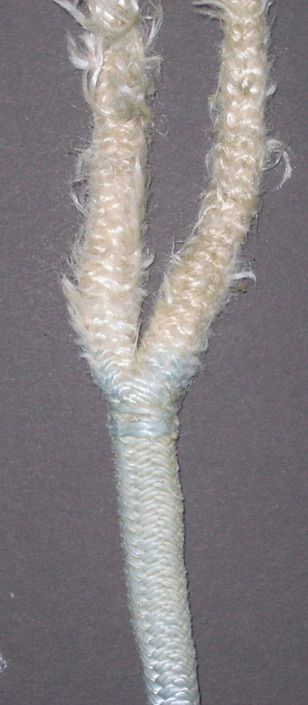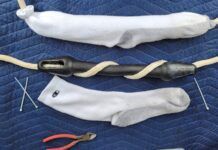
The importance of carefully whipping any eye-splices became apparent early on in the testing.
Fully 70 percent of our test samples, including new and used line from New England Ropes and Samson Ropes, experienced failure of pre-spliced eyes (see Splice Failure table). The buried portion of the core worked its way out of the main line and into the eye, where it carried zero load. In some cases, these failures were scarcely visible, while in others, the tail was exposed.
Since it takes only a few minutes to stitch a splice. Why risk the chance of failure?
We also noted that new braided lines tended to herniate (see New- Line Cleaning table). The continuous back-and-forth milking of the cover in wet soapy water is what causes the trouble, something a rope never sees in real use.
LINE CARE: New-Line Cleaning Test
| CYCLE | SAMPLES | DAISY CHAIN (D) COIL (C) | DOUBLE BRAID DAMAGE NEW ENGLAND ROPES | DOUBLE BRAID DAMAGE SAMSON |
|---|---|---|---|---|
| STANDARD DOSE OF TIDE HD | ||||
| Gentle | 2 | D | Herniated core through cover every 6-12 inches | 100% of eye splices failed (core puled out) |
| Gentle | 2 | C | Herniated core through cover every 6-12 inches | 50% of eye splices failed (core pulled out) |
| *Cleaning ratings: 1=Excellent, 5=Poor |
LINE CARE: Splice Failure
| CYCLE | SEWN AND WHIPPED | SPLICED ONLY |
|---|---|---|
| Gentle | No failure of 6 samples | 3 of 4 samples failed |
| Normal | No failure of 6 samples | 4 of 4 samples failed |
| Heavy duty | No failure of 6 samples | 4 of 4 samples failed |
| All ropes washed in daisy chain, new rope |



































